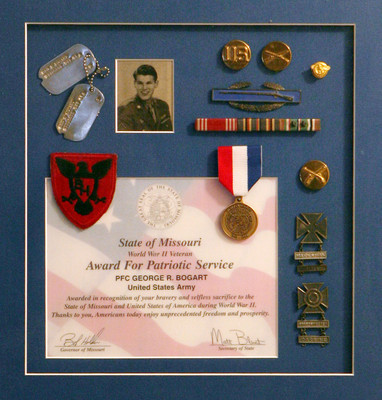TENDER MERCIES
It was the Christmas spirit after World War II that inspired Army Pfc. George Robert Bogart to go into town and buy some art supplies for a German prisoner at the El Campo, Texas, compound in 1945.
"I thought, 'How precious,' " Bogart's widow, Dorothy, said, sitting in the living room of her Las Vegas home, surrounded by scrapbooks, line drawings and a painting that her husband finished decades ago.
"He bought supplies so this prisoner could paint," she said. "It was about giving and forgiving.
"This was the true Christmas spirit. People are losing that. It's so commercialized now," she said.
Dorothy recalled the motivation of her "honey, Bob," who died Jan. 29.
Freedom was still on the distant horizon for the German prisoner, Walter Hoffman. But the man who guarded him was so impressed by his talent as a portrait artist that he did what he could to ease the pain of confinement.
"Despite what bitterness there was after the war, he had a tenderness for Bob," she said.
Bogart himself had a knack for drawing and painting. After his honorable discharge in 1946, the young soldier from the U.S. Army's 86th Infantry Division pursued his passion and used his GI Bill to attend Kansas City Art Institute for four years. That launched his 32-year career as a visual information specialist for the Army Corps of Engineers.
Dorothy Bogart said her husband's pen-and-ink version of the much larger, vintage-1969 oil painting on her wall depicts the mayor of Sumner, Mo., rowing a boat while jug-fishing for catfish on the Missouri River. His work from Independence, Mo., had graced the cover of an Army Corps of Engineers magazine.
But it was the postcard rendering of a snow-covered cabin, flanked by white-flocked evergreens below a crescent moon on a starry night, perhaps in Germany or Austria, that was the focus of her conversation.
"Probably it was a copy of a winter scene the artist (Hoffman) had painted," she said.
On the back was a note.
"Do you still think of me? Certainly you have forgotten the german painter who did so many portraits whilst being in the states," reads the fountain-penned note to "Dear Georg," that contains a few spelling and grammatical errors.
"In January 1948 I got home. Our home was slightly damaged but everything is restored now. How do you do in the states? If you get time, please write to me," reads the printing on the yellowed card, signed, "Yours sincerely Walter Hoffman."
Dorothy Bogart, who turned 83 Monday, said the card has deeper meaning than the few sentences that Hoffman wrote.
"To me it's a tribute to my husband who was compassionate to the unfortunate," she said. "Also, on the other side of the coin, it would be a tribute to a German prisoner who must have thought a lot about Bob to send him a Christmas card.
"There was no bitterness there. He knew that side of Bob that I knew. Bob always loved beautiful music and fine art," she said.
She said she can't remember exactly when Hoffman sent her husband the card but it was sometime after they were married in 1950. Hoffman never sent a photo of himself.
"Bob said he felt bad he hadn't kept up on writing him," she said. "In the compound, these Germans would sing and sway with the music. He was so impressed with the attitude of the prisoners."
The El Campo prison camp was surrounded by a 7-foot-tall fence topped by 10 strands of barbed wire and a sentry post in each corner, according to the local newspaper, the El Campo Leader-News, which cites the research of Art Keinarth, a colonel and former city councilman.
"Flood lights illuminated the entire enclosure," Keinarth wrote in 1994. The camp closed in September 1945 and was later used as housing for migrant workers.
George Robert Bogart was born Sept. 16, 1925, in Kansas City, Mo., with a pair of dislocated shoulders. Because of his parents' religious beliefs, they never sought medical help to correct the problem, his wife said.
Nevertheless, in the midst of World War II, the Army found him fit enough for the draft in 1943. He advanced through training as a carbine rifle sharpshooter, hitting targets from the prone position with pillows under his arms.
Because of his physical disadvantage, though, he spent much of his time in the Army as a truck driver.
"One officer told him, 'It's a shame. You have a high IQ. You would have made a fine officer,' " said Dorothy, who retired as a special education teacher in 1988, and authored a book 13 years later, "Courageous Virginians."
The 86th Infantry, known as the "Blackhawk Division," spent 34 days in combat in Europe. The division's combat chronicle describes how the soldiers arrived in France on March 4, 1945, "and moved to Koln, Germany, taking over defensive positions near Weiden ... in relief of the 8th Infantry Division."
After patrolling both sides of the Rhine River, the 86th cleared Attendorn on April 11, 1945, engaged in the fight at Ruhr, then advanced crossing the Danube on April 27, 1945, later moving east to Salzburg.
In the ugliness of war, Private Bogart found beauty in the architecture and the landscape.
"He thought the buildings in Europe were beautiful," Dorothy said.
After the war in Europe ended, the 86th returned to New York in June 1945 and was sent for a few weeks training at Camp Gruber, Okla. Many of the soldiers shipped out from San Francisco destined for the Philippines on Aug. 24, 1945.
But with only a few months left in his enlistment, Pfc. Bogart was dispatched to Texas to guard the 250 German prisoners at the El Campo compound, 70 miles southwest of Houston in Wharton County.
"These prisoners worked in the rice fields, harvesting and thrashing," Dorothy said. "After the crops were in, Bob was then sent to a larger prisoner-of-war compound near Austin."
From there, his prison guard duties continued, escorting a troop train to Long Beach, Calif., and again aboard the USS Ernie Pyle that carried 1,900 German prisoners through the Panama Canal to Liverpool, England.
He first saw Dorothy two months after his discharge while waiting for a trolley car in May 1946. A student at the University of Missouri at Kansas City, she had skipped class on a Friday and was on her way back to Independence.
So was he.
"I got out the front door and he got out the back," she said.
They waited a long time for a bus at the transfer point. When it came, another woman sat between them. When the lady got up to leave, "The next thing I knew there was this body beside me. He was a brave man. ... He said, 'Would you go out with me?'
"We went to a motion picture show. I knew if I didn't go out I would never see him again. And that began our courtship," she said.
Dorothy Houchens and Bob Bogart were married June 10, 1950, in a Baptist church in Independence, where Dorothy had grown up three blocks north of the home of President Harry Truman and his wife, Bess.
Over the years, they lost contact with Hoffman but he apparently succeeded as an artist.
Three samples of magazine covers drawn and colored in the mid-1950s by an artist named Walter Hoffman are listed as being auctioned on the Artnet Web site. Artnet lists his nationality as Austrian with a question mark.
Smiling women in winter ski scenes are depicted in a simplistic style in two of the magazine covers. One shows snow drifts similar to what appear on the postcard on Dorothy Bogart's wall.
The Bogarts spent most of their 56 years of marriage in Independence, moving to Las Vegas in 2005 to be close to their daughter.
Before Bob died, he drew covers for church bulletins and nativity scenes, as well as writing a Christmas story.
He was fond of Rudyard Kipling poems. At his memorial service in Independence, one, "L'Envoi," was recited:
"When Earth's last picture is painted, and the tubes are twisted and dried,
"When the oldest colors have faded and the youngest critic has died ...
"But for the joy of the working, and each in his separate star,
"Shall draw the things as he sees it for the God of things as they are."
Contact reporter Keith Rogers at krogers@reviewjournal.com or (702) 383-0308.



















